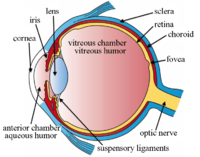
Photo from wikipedia
Purpose: To determine the effects of bevacizumab, ranibizumab, and aflibercept on the permeability and the effects of anti–vascular endothelial growth factor (VEGF) on highly polarized retinal pigment epithelial cells (RPECs)… Click to show full abstract
Purpose: To determine the effects of bevacizumab, ranibizumab, and aflibercept on the permeability and the effects of anti–vascular endothelial growth factor (VEGF) on highly polarized retinal pigment epithelial cells (RPECs) in vitro. Methods: Highly polarized RPECs were cultured in the upper chamber of a Transwell system. Anti-VEGF antibodies were added to the upper chamber, and the concentrations of the drugs in the lower chambers were measured. The permeability rates of the three anti-VEGF drugs through the RPEC layer and the concentration of VEGF in each chamber were determined. Results: The permeability of aflibercept was significantly lower by about 40% than that of bevacizumab through the RPEC layer (P < 0.05). Ranibizumab was significantly more permeable through the RPECs than bevacizumab (180% of bevacizumab, P < 0.05). Although VEGF was almost absent in the upper chamber after exposure to the 3 antibodies, it was decreased more significantly with aflibercept than with bevacizumab in the lower chamber (2.8% vs. 65.8% of control; P < 0.01). Ranibizumab also decreased the VEGF level compared with bevacizumab (31.7% vs. 65.8% of control; P < 0.01). Conclusion: The greater reduction of the amount of VEGF in the lower chamber by aflibercept and ranibizumab than bevacizumab may explain why aflibercept and ranibizumab are more effective than bevacizumab against type 1 choroidal neovascularization.
Journal Title: Retina
Year Published: 2017
Link to full text (if available)
Share on Social Media: Sign Up to like & get
recommendations!